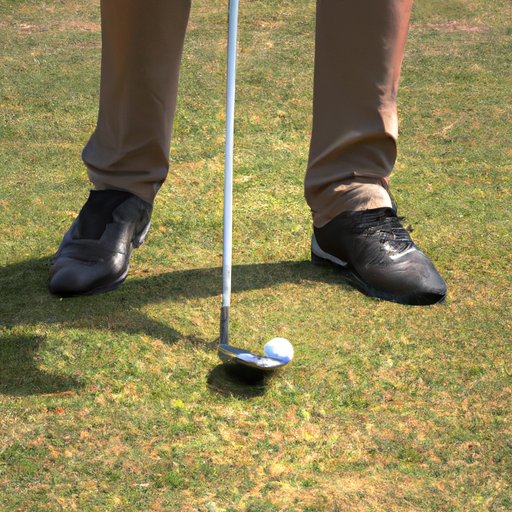Introduction
Many new golfers struggle with the difficult task of hitting a golf ball consistently. It is a skill that requires patience, perseverance and the right technique. Knowing how to hit a golf ball properly is important to improve your game and reduce your score. This article is a comprehensive guide to perfecting your swing, starting from the basics and progressing to advanced tips and techniques.
How to Perfect Your Stance and Swing: The Art of Hitting a Golf Ball
Having the right stance and swing is an important aspect of hitting a golf ball. It’s essential to have a good balance, a proper grip, and correct posture to make accurate shots. Here are some tips for setting up your stance:
- Start with a shoulder-width stance with your feet pointing straight ahead.
- Place your ball in front of your left heel if you’re right-handed and vice-versa for left-handers.
- Lean forward slightly from the waist towards the ball, keeping your arms stretched and your elbows close together.
- Make sure your head is positioned directly over the ball.
To execute a good swing, follow these steps:
- Address the ball and visualize where you want it to go.
- Start your backswing with your left shoulder for right-handed golfers and right shoulder for left-handers.
- Shift your weight to your back foot as you turn your shoulders and hinge your wrists.
- Bring the club down smoothly by driving your hips towards the target and shifting weight onto your front foot.
- Make contact with the ball and follow through to finish your shot.
Mastering the Basics: A Step-by-Step Guide to Hitting a Golf Ball
A good pre-shot routine can help improve your accuracy and consistency. You should begin by taking a few practice swings to get a feel for the club and also to establish a rhythm. Once you’re ready to hit the ball, follow these steps:
- Stand behind the ball to choose your target and find a spot in front of the ball to align your shots.
- Take your stance, set your club behind the ball and align it with your target spot.
- Align your feet with your hips parallel to your target line.
- Keep your arms straight, shoulders relaxed, and chin up.
- Begin your backswing by gradually turning your shoulders as you shift your weight to your back foot.
- Start your downswing by shifting your weight back to your front foot, and turn your hips towards the target.
- Make contact with the ball and follow through to complete your swing, with your chest and belt buckle facing your target.
The Fundamentals of Hitting a Golf Ball: Tips and Tricks from Experts
Staying balanced throughout your swing is important to maintain control and power. Weight transfer is also a crucial element of hitting a golf ball. In order to achieve a smooth and effective swing, proper tempo is required. Practicing for consistent ball contact can be challenging but it is essential in improving your game. Here are some tips from experts:
- Focus on your balance and stay relaxed throughout the swing.
- Keep your feet planted firmly on the ground and transfer your weight smoothly as you swing.
- Find a tempo that works for you, and avoid rushing your shots.
- Practice regularly at the driving range to improve your contact with the ball.
The Science behind Hitting a Golf Ball: Understanding Ball Flight and Club Head Speed
Golf is a sport that combines skill and science. Understanding the properties of the golf ball and how it interacts with your club face can help you better control your shots. Here are some key concepts to understand:
- The dimples on the golf ball produce lift and reduce drag, which determines how high and far your ball travels.
- The angle of the club face upon impact also affects the ball’s trajectory and its spin rate.
- Increasing your club head speed can improve your ball distance, but it requires the right technique and fitness level.
Common Mistakes to Avoid When Hitting a Golf Ball: Tips for Improving Your Game
There are some common mistakes that golfers make when hitting the ball. These can be corrected with the right techniques and proper guidance from professionals. Here are some tips:
- Avoid swinging too hard or too fast as this may cause you to lose your balance and accuracy.
- Don’t try to lift the ball off the ground, but instead focus on striking the ball with a descending blow to create the correct spin and lift.
- Course management is an important aspect of the game and can help you avoid making errors.
Beyond the Driver: Hitting a Golf Ball with Different Clubs and Techniques
Each type of golf club has its own use and is designed to hit the ball in a specific way. Understanding how to use different clubs and techniques can help you tailor your game to suit different conditions. Here are some tips:
- Wedges are used for short shots and are hit with a slower swinging motion.
- Irons are useful for medium-length shots and require a more angled swing.
- Fairway woods and hybrids are designed for longer shots and require a flatter swing.
- Understanding how to make adjustments for different lies and conditions on the course is key to improving your game.
Conclusion
In conclusion, hitting a golf ball is an art that requires a lot of skill and practice. By mastering the fundamentals of proper stance, swing, and contact, you can improve your accuracy, increase your distance, and lower your scores. It takes commitment and patience, but with the right techniques and tips, you can become a skilled and confident golfer.
